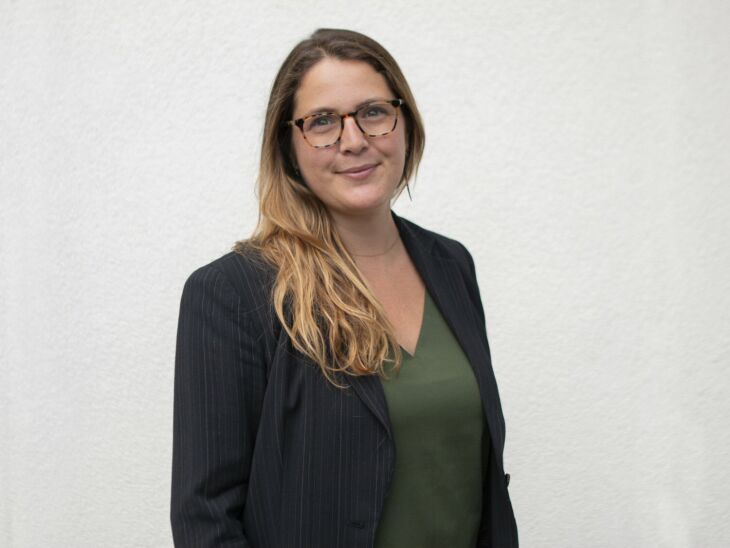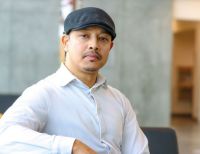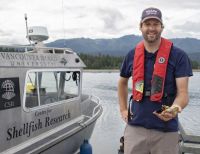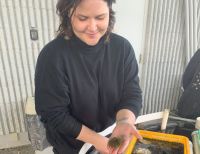VIU community-engaged research team working with youth to use art as a conduit for self-care, language learning and as a relationship-building tool.
A team of Vancouver Island University (VIU) community-engaged researchers is working with Indigenous youth on a project that is empowering them to explore important issues and share knowledge with the wider community through an artistic work.
The youth are students at Tsawalk Learning Centre, a community-based learning program for students in Grades 8-12 that has Indigenous ways of knowing and learning integrated into the curriculum.
The aim of the VIU research project is to use art as a conduit for self-care, relationship building, language learning and as an avenue to communicate with the public. It is part of the work Dr. Amanda Wager, VIU’s Canada Research Chair in Community-Engaged Research, is exploring with the team at her research centre called arc: A Centre for Art, Research and Community.
“Art is like a catalyst. It’s a way to transfer information and is an accessible way for people to get information and build relationships,” says Wager. “It’s important that we know what the young people in our city want to explore. I want community members to listen to our young people. They have so much insight into things we would never think of.”
The youth at the Tsawalk Learning Centre have been working with Indigenous artists Amanda Strong and Bracken Hanuse Corlett over the last three months. The group is primarily focusing on digital art as the artists are teaching remotely and showing the youth how to use video editing, animation and a digital design app on an iPad. The youth choose a medium and research topic that is meaningful to them and create a digital art piece that conveys that subject to the public.
The late Elder Sally Williams and current Elders-in-Training, Quuia (Greg) Charleson and Bex Manson have started weekly sessions with a sharing circle. As well, they have supported the youth by helping them in choosing words and phrases to add to their projects from the local languages of Hul’q’umin’um’, Nuu-chah-nulth and Kwak’wala.
Youth leader Madison Olebar, who is working with another youth in the program, chose the Red Dress Project, which focuses on the issue of missing and murdered Indigenous women and girls. Olebar chose the topic because it has personal meaning to her. She was assaulted a few years ago and the trauma she experienced later led to her having an argument with her parents and running away from home.
“When I finally got back, I realized how much people were worried and I saw how much I meant to people,” says Olebar. “I started getting into the issue of missing and murdered Indigenous women after seeing how much my family was worried about me. I wanted to learn more about it because I didn’t know much at the time and it just became more meaningful to me.”
Olebar and her partner are creating a tree out of wires and clay. The tree, along with a background, will be black and white to create a stark contrast to participating models, who will wear red dresses. They will photograph and film the models as the final part of the art piece. The video portion of the project will feature the song created by Lummi Nations’ Antone George of the WestShore Canoe Family, which was written to honour missing and murdered Indigenous women and girls.

Becky Thiessen, arc Research Centre Coordinator.
Becky Thiessen, the arc Research Centre Coordinator, says the community-engaged research Wager’s team is doing with the Tsawalk Learning Centre is about having open discussions and building relationship and trust among everyone.
“The youth are learning integral skills and practical methods to visually express the concern they have for themselves, each other and their greater community,” says Thiessen. “This work teaches them that their voice is valid and it should be heard. I believe that learning to think critically, creatively and developing one’s imagination are essential skills when figuring out life’s challenges. I hope the youth continue to thrive in their questioning and creativity.”
The project was funded by a $20,000 Convene Grant from the Vancouver Foundation and a $10,000 ArtStarts Grant. The youth, either as individuals or pairs, participating in the project will create their own digital art piece, either an image or a video that will highlight their research question and dig deeper into the issue. All the projects will be compiled into a video file that will be shared via social media at a later date.
-30-
Media Contact:
Rachel Stern, Communications Officer, Vancouver Island University
C: 250.618.0373 l E: [email protected] | T: @VIUNews
















